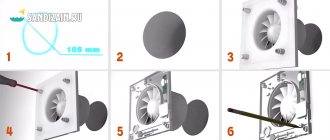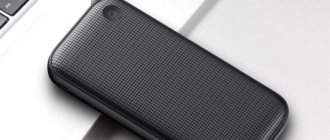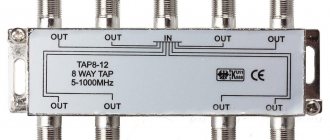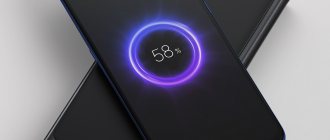If you are doing repairs, among other things, the question arises of buying a television cable and, of course, the sacred “which TV cable is better?” On sale there is a carload and a small cart of varieties of antenna wires, which differ in markings, name, thickness, characteristics, color, etc. Not to mention the fact that different types of television offer “their own” cables.
Let's be honest, this abundance sometimes baffles even specialists. Therefore, we want to tell you what cable is needed to connect the TV, and how to check whether the installation wizard offers the right type.
The structure of a television cable
The cables are arranged, in general, the same way. There is a main central core or inner conductor. The core is hidden in an insulating sheath, on top of which a screen and braid are laid. And the protective shell completes everything.
Note! A cable of this structure is also called coaxial. Thus, the cable for the TV is coaxial.
The internal conductor transmits the signal in all types of television and power for the converter in satellite TV. Therefore, it is made of copper or copper-plated steel. That is, the vein itself is steel, and on top there is a thin layer of copper, sort of like steel wires were dipped into a bath of molten copper. A pure copper core is needed only for the satellite; for the rest, a copper-plated steel core works great. Plus, the price of the cable is lower, but the quality is high.
The screen and braid act as protection against various interferences. The better they are made, the better the TV signal will be. The screen is made of aluminum foil and/or aluminum lavsan (screen), the braid is made of aluminum, copper or tinned-copper wire. The average protection factor or shielding factor is 60-80 dB, high starts from 90 dB.
The internal plastic dielectric reliably hides the central core, protecting it from damage. It also insulates from contact with the screen and braid. The outer sheath made of polyvinyl chloride (PVC) covers the entire contents of the cable, protecting it from damage and external influences. For example, from water, dust, temperature changes and other troubles. After all, cables are often laid not only indoors, but also outdoors.
How to connect
The fastest and most convenient way to connect the antenna cable is to use an angled or straight F-plug.
Angled and straight F-plug (plug)
To put on such a plug, all you need is a knife. We will demonstrate in detail how this is done:
- Using a knife, cut the protective layer;
The protective layer is being cut Result of the cut
- When the outer layer is removed, the conductor-screen and foil (if any) are wrapped;
Wrapped Screen
- The insulation is removed from the central core;
The central core is freed from insulation
- The F-plug is screwed on;
Twisted plug
- At a distance of about 3 mm from the plug, the excess part of the central core is cut off;
The process of cutting the central core
- The top part of the plug is screwed on.
Brands and characteristics of antenna cable for TV
Coaxial antenna cable is available under different brands, the most commonly used of which are: SAT 50, SAT 703, RG 6, RG 59, DG 113, RK 75. All of them have a characteristic impedance of 75 Ohms and are suitable for connecting one or more TVs. Now let's talk about each type in more detail.
RG-6 cable
| RG-6 cable |
The brand is Russian, but made in China. The central core is copper or steel with copper plating, thickness 1.0 mm, hidden in a sheath of foamed polyethylene. The cable has a foil screen, copper or aluminum braiding and a protective PVC sheath. The total thickness of the wire is 6-6.8 mm. Most often, the RG 6 brand is used for cable, regular and digital TV. This is the most inexpensive variety with a price per meter starting from 10 rubles.
Cable RK 75
Similar to RG-6 in terms of characteristics, produced in Russia. The central core is made of copper, thickness 1.0 mm, PE dielectric, screen made of copper braid or double screen made of aluminum lavsan and tinned copper (foil and braid). A cable with a single shield can be used for terrestrial and cable TV, while a cable with a double shield can also be used for a satellite dish inside a building.
Cable RG 59
A thinner version of RG-6 with a central core thickness of 0.5-0.58 mm and an outer diameter of 5.4-6.0 mm. Suitable for transmitting all types of signals, including satellite, but over a distance of 190 m. Due to the thinness of the main conductor, the signal in the cable attenuates 50% more, and the loss of image quality increases with each meter.
Attention! RG 59 and other analogues with a half-millimeter core are used for one television receiver. A fragile and thin conductor is more difficult to secure in sockets and connectors; it easily breaks if the wire is laid inaccurately and if the wire is strongly bent. And high attenuation “brutally” weakens the signal when connected in a serial circuit.
SAT 50 cable
| SAT 50 cable |
Manufacturer: Italian company Cavel. The central copper core is 1.0 mm, the screen is reinforced, consists of two layers of foil and copper-tin braid, shielding coefficient from 60 dB. The conductor sheath is made of PEG dielectric, the outer one is made of PVC, cable diameter is 6.6 mm, kg. It can transmit all types of television signals - broadcast, cable, digital and satellite. Price per meter from 30 rubles.
SAT 703 cable
| SAT 703 cable |
Also products under the Cavel brand. The central conductor is made of copper with a thickness of 1.13 mm. Screen made of two layers of aluminum-plastic foil and copper-tin braid, shielding coefficient from 80 dB, shell made of PEG dielectric and PVC, total thickness - 6.6 mm. It transmits all TV signals with high quality and is recommended for satellite TV, including outdoor installation. Price per meter from 40 rubles.
Cable DG 113
| Cable DG 113 |
Manufactured by Cavel, technical indicators are similar to the SAT 703 brand, but the shielding coefficient of DG 113 is higher and starts from 90 dB. This ensures high-quality transmission of high-frequency signals without interference. Excellent cable for indoor satellite dish. The most expensive antenna cable. The cost of a meter starts from 65 rubles.
Compound
After purchasing a suitable cable, you need to connect it to your TV. This stage is no less important than the choice of wire, since even the most expensive and high-quality product will not transmit a good signal if the connection is made incorrectly. Installing the plug It is recommended to buy plugs from the same store where you buy the cables. Ask the seller to help you select the appropriate components. The most common type of plug is the F-plug. It is designed to transmit both analogue and digital television signals.
Connecting the plug to the antenna wire is very simple:
- Using a utility knife, make a circular cut of the top protective layer up to the screen shell, a couple of centimeters long;
- After removing the outer shell, carefully bend the shield or braid back. Fold part of the foil again so that not the inner, but the outer part of it contacts the plug;
- Remove the insulating sheath of the center wire;
- Place the plug on the cable and twist it clockwise until it stops;
- Cut off any excess wire.
Plug installation is complete.
It is also useful to watch the video on how to connect a television plug to a coaxial cable:
Sometimes the quality of the TV signal suddenly decreases. In such cases, it is necessary to identify the causes of signal deterioration and eliminate them.
- If the cable is damaged, you first need to find the break point. Next, divide the cable into 2 parts and perform the same operation with each part as when putting on the plug. Buy special attachments that fit onto the cable and connect the damaged parts.
- You can extend the cable in the same way. It is recommended to use a cable of the same brand and model for extension.
- Signal quality may also decrease due to sharp turns of the television wire. Do not bend the cable sharply 90 degrees. Be sure to bend the cable within a certain radius.
Be sure to watch the video on how to connect a television cable:
Satellite, cable, digital TV - which cable to choose
Surely you are interested in:
- what antenna cable is needed for digital television;
- which television cable is best for cable TV;
- which television wire is better to use for a satellite dish.
From practice we know for sure that dividing into so many types of television and selecting a cable for each is a waste of time and money. The reason is simple: the frequencies of channels, regular terrestrial, digital TV and cable channels, are not very far apart and fit in the range from 49 to 800 MHz.
This gap is qualitatively “closed” by all types of cables of the brands SAT 50, SAT 703, RG 6, DG 113, RK 75. And if the total length of the television wiring is up to 20-30 meters, then the signal attenuation is practically not felt. Even RG 59 copes well with work in a star circuit or when connecting one TV.
| SAT 50 cable | SAT 703 cable | RG 6 cable | Cable DG 113 |
Advice from 220pro.ru! Feel free to choose one type of cable for digital, terrestrial and cable television.
And to the question: which television wire is better for digital or cable TV? — let’s answer this — any of the Cavel cable family will give a 100-point head start to other brands. But, if you need to “fit” into a budget option, RG-6 is also suitable.
Antenna wire for satellite television
Satellite channel broadcast frequencies are higher and are measured in thousands of megahertz. The cable must transmit them without significant losses, which are noticeable in the high-frequency range and grow rapidly with each meter. Plus, there is a transmission of special pulses and supply current for the converter local oscillator.
In addition, satellite channels are more sensitive to electronic interference, which means that effective cable shielding is required. The stability of the outer shell is also an important thing. The satellite dish is located outside, and part of the wire will be on the street. And there all the delights of the weather and precipitation will begin to actively age and destroy the shell
Therefore, choose a high-quality cable with lower attenuation, durable copper core, excellent screen and reliable sheath with carbon protection.
Advice from 220pro.ru! We recommend antenna wire for satellite television brands SAT 50, SAT 703, DG 113 or their analogues.
Tips for organizing a cable network
Before planning a wired network inside your home, you should know that only 75 Ohm cable is needed for digital TV . It is also necessary to find a reasonable balance between the thickness of the wire and the nature of its installation. A thicker cable has a lower signal attenuation coefficient. Theoretically, it will allow laying long lines. But in practice, such a product is more difficult to bend. When laying transmission lines, it is worth remembering:
- each bend in the line means loss of signal;
- At the point of bending, the screen will eventually collapse and the coaxial structure will be affected by interference.
Important! You cannot use a cable that is too thin; it is necessary to plan the laying line so that it has a minimum number of bends, the angle of which should not be equal to 90 degrees.
In addition, the cable network needs to be segmented.
- A line is led from the antenna into the house using a coaxial wire for external installation. Its brand is selected based on the distance from the receiving device to the nearest switching point.
- The wire from the antenna goes to the terminal box or divider.
- The lines from the divider outputs to consumers are laid with a cable for internal use, for example, ST-50.
- If the signal drops significantly, it is recommended to install amplifiers at key points in the network.
The key point of the network means the minimum distance to the receiver or consumer. Thus, the amplifier is installed immediately after the antenna with as short a signal wire length as possible. The same rule applies to a TV or set-top box. If you need to ensure picture quality at a consumer at a remote point in the network, the amplifier is placed directly in front of it.
The best option
Without antics and dancing with a tambourine, let’s say that a high-quality branded Cavel television cable is a super-optimal option in terms of price-versatility. You get much more than just excellent technical specifications and a beautiful picture on your TV.
- Workmanship.
The branded cable is an order of magnitude higher than the budget analogue. For example, in inexpensive assortment (especially made in China) it is very easy to pull out the cable stuffing from the sheath. With the luxury Cavel cable, you will be tortured to tear off even a small piece of “skin”. - Versatility of installation.
The branded wire is thicker, stronger, and fits perfectly under the plaster like in a cable channel. And when installed externally inside the plinth, Cavel easily withstands mechanical stress. - Reliability of contacts.
All connections to sockets, plugs, etc. make good contact when using a proprietary Cavel cable. Because it is made of high quality materials.
Amplifiers
To amplify the television signal, special devices are used - amplifiers. The device should be close to the TV or antenna. Most often, amplifiers are used to compensate for signal loss due to the use of crabs.
Connecting the TV to the antenna via a video amplifier:
As you can see, choosing and installing a good television wire for an antenna requires taking into account many nuances. But it’s worth it, because with the right choice of TV cable, broadcasting will proceed without interference. We hope that the article on television cables will help you make the right choice.











